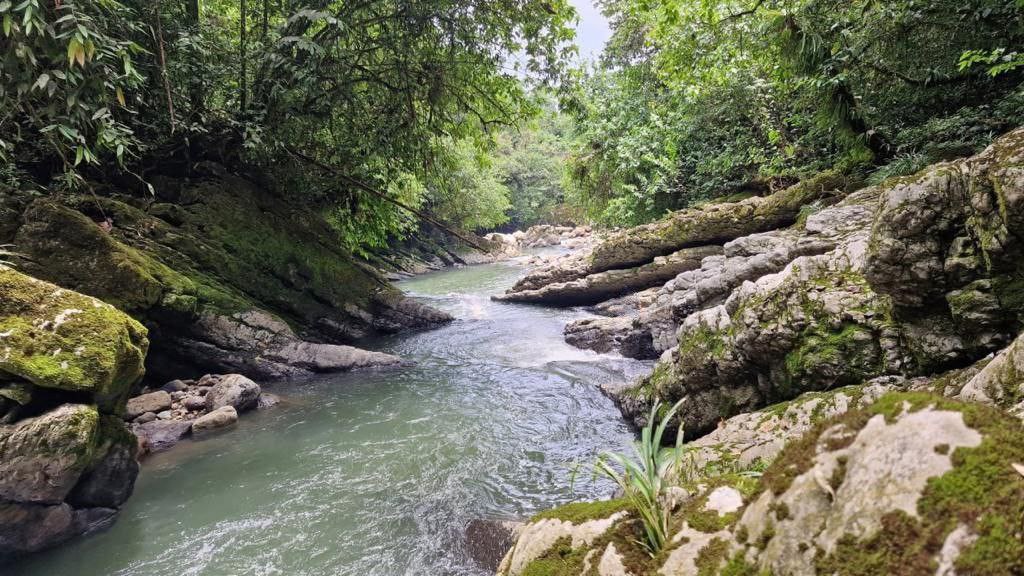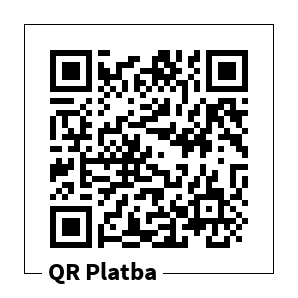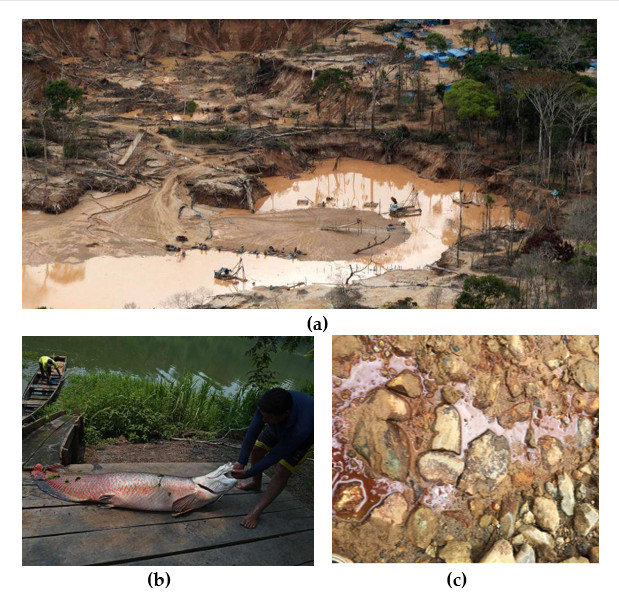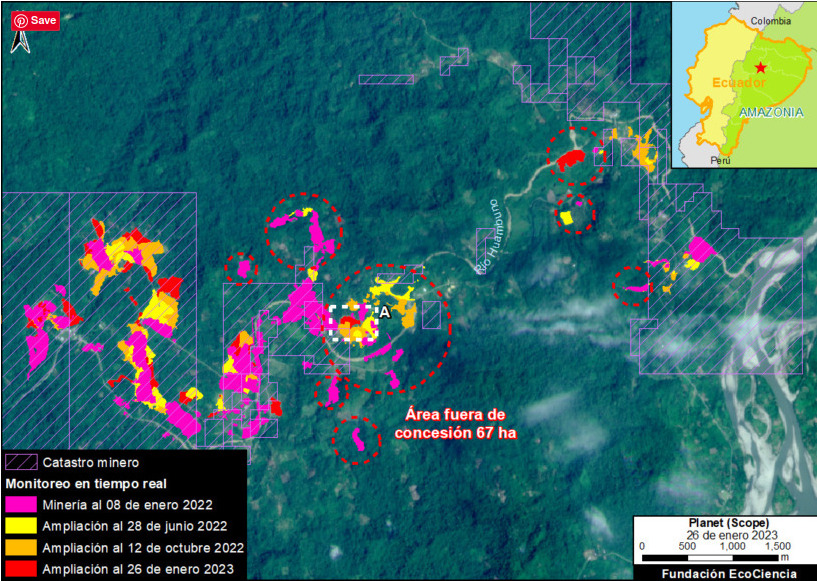The Threat of Mining: Protecting the Rainforest and Flourishing of the Jungle School
Your support has already enabled us to save over 63 hectares of rainforest from the destructive interventions of gold mining companies. Thanks to this, we have been able to preserve a precious piece of nature and provide a refuge for many species of medicinal plants and animals. Our mission, however, continues.
What problem are we facing?
Miners continue to target the accessible lands along the Huambuno river, applying unrelenting pressure on the families holding property near the waterfall. Sadly, during the two weeks when we were working on the legal status of the 23 hectares we just protected, one family gave in to the pressure of mining companies and allowed mining on part of their land.
This land represents the last of the easily accessible sites for potential mining expansion++ — beyond the waterfall, the rugged terrain becomes a natural barrier. Mining operations here pose a direct threat not only to our conservation achievements but also to the local inhabitants who steadfastly refuse to sell their homes.

Strategy and Land Protection
Our goal is to raise sufficient funds to be able to respond immediately, prevent further damage, and protect the remaining easily accessible land against illegal mining. This would not only protect the ecosystem and prevent the pollution of the river, but also provide space for the rainforest school, Sachawa. In light of the rapid progress of logging, and the associated contamination and deforestation of the rainforest, this is a matter concerning the future of us all. It is essential to maintain the diversity of species on our planet and ensure that our children can continue to draw inspiration, joy, and medicine—all of which the rainforests provide.
Our vision is to create a protected area and an education center from the entire territory that will educate future generations on the protection of the rainforest.
A place where children from various cultures around the world could meet, enrich and inspire each other. In doing so, we would help educate a generation that is not only educated but understands the importance of preserving the wilderness. We realize that this is important not only for the local communities, but also for the flora and fauna, and all of us who live on Earth now and will live in the future.
“We must not forget our hearts, we must not forget who we are, because nature is an integral part of us. Nature gives us balance. Nature is the foundation for all people and for every living being.”
“I know I cannot change the entire planet, as my grandmother used to say. But we can change people’s hearts. People can realize that every action counts and that everything is important.”
Augustin Grefa
Conservation and Rainforest School: Financial Goals
To save this entire area, we need to raise $160,000.
Our vision extends beyond mere protection of this land; we aim to preserve it for future generations and to establish the Sachawa rainforest school as a legal entity. This school is poised to educate and ignite passion not only in local children but also in youngsters globally who wish to immerse themselves in the rainforest’s splendor and unravel its secrets and significance.
To build the basic structures of the school, we need to raise an additional $93,000.

Bank Account: 34800348/2010
IBAN: CZ9420100000000034800348
BIC/SWIFT: FIOBCZPPXXX
Transactions on the transparent account.
* When browsing from a mobile device, payment can be made by saving the image and then loading it in Internet Banking.

What we’ve accomplished together until now
The organization Život Postaru was founded in 2012 with the goal of protecting the Amazon’s natural environment and supporting indigenous communities in the Ecuadorian part of the Amazon Rainforest. Throughout its existence, it has achieved numerous significant successes and brought about many positive changes. Nevertheless, we remain tirelessly committed to new challenges and missions aimed at protecting the forest and preserving indigenous wisdom.drosti.
Here are the main achievements that the organization Život Postarustands behind:
- Year 2012: We successfully protected 40.5 hectares of land from gold mining, contributing to the conservation of the rich biodiversity of the rainforest in that area.
- Year 2014: We conducted education and awareness for the Rio Blanco community about 21 indigenous rights, including rights to protect the rainforest.
- Year 2016: We purchased a piece of land with a lagoon, which is home to numerous endangered species and medicinal plants. This contributed to their protection from dangerous oil drilling.
- Year 2017: We initiated the Wayusa project to create a sustainable future for this traditional practice of drinking Wayusa. We thus assist indigenous families with income from the sale of this healing, organically grown tea.
- Year 2019: We introduced a program for the remote adoption of trees to protect ancient trees from the logging industry. These ancient trees are crucial for maintaining the balance of the rainforest and the environment.
- Year 2019: We founded the association Ruku Samay (translated as Život Postaru) in Ecuador, which currently has 20 members, predominantly indigenous people. Their aim is to show other communities the possibility of protecting indigenous culture and traditional life in the rainforest through innovative projects.
- Year 2020: We organized a meeting with wise elders to discuss how to preserve indigenous wisdom and connection with nature for future generations. The result was the establishment of the indigenous school Sachawa.
- Year 2020: We established the Sachawa Saturday school, which promotes indigenous wisdom and tradition and educates future nature protectors.
- Year 2020: We assisted the Rio Blanco community in proving the legality of their lands in the Coca area, where illegal settlement and logging had occurred due to forged documents. Thanks to financial support from the „Život Postaru“ organization, we reached an official agreement that they will not sell their lands to miners in the future.
- Year 2021: We created a one-hectare botanical garden of medicinal plants, where we provide permaculture education and ensure the protection of endangered plant species. We also built a community house measuring 8×16 meters near the botanical garden to provide accommodation for future volunteers who will come to support our foundation.
- Year 2022: We launched a collection to support day study at the Sachawa school with the help of Meltingpot at the Colours of Ostrava festival.
- Year 2023: We successfully saved 23 hectares of rainforest in the Rio Blanco area from gold mining, which had the potential for a destructive impact on the local ecosystem and the many families living in the area.
- Ongoing: We work with local indigenous residents and help them secure protection for their territory.
- Planned activities: We plan to introduce a child adoption program in the school so that indigenous families can study daily at the Sachawa School of Indigenous Traditions, thus contributing to the protection of indigenous wisdom.
++ Near the waterfall, there is another plot of land that currently does not present an immediate interest to miners due to its poorer accessibility. Although this land is less accessible at the moment, the theoretical possibility of mining exists. This fact motivates our need to prepare for the future protection of this land. In the future, we plan to strive to purchase it in order to prevent any possible negative impacts that mining could cause.
